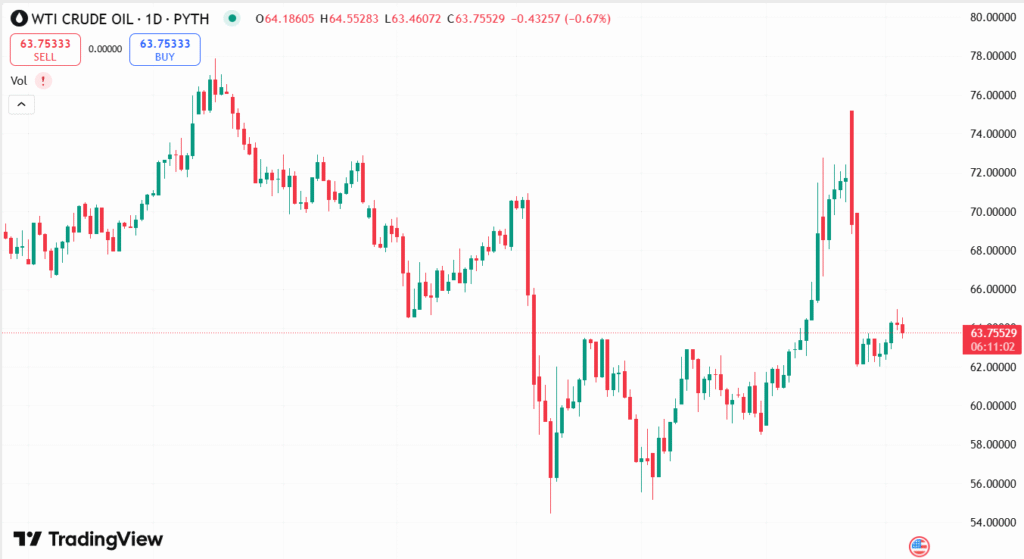West Texas Intermediate (WTI) crude oil hovers with caution at around $66.00 as the market remains in suspense before the July 9 tariff deadline announced by U.S. President Donald Trump. With Trump assuring not to extend the deadline for those countries who are not able to agree on a trade deal with Washington, threats of retaliatory tariffs hang over global trade and energy demand. While the U.S. managed to conclude deals with the UK, Vietnam, and Canada-China framework, uncertainty over other important partners such as the Eurozone, Japan, and Canada continues to put pressure on oil markets. Also, robust U.S. jobs data have decreased prospects of a Federal Reserve rate cut this month, further capping oil price upside potential.
KEY LOOKOUTS
• Market attention is still on President Trump’s order to apply tariffs to countries that do not have trade agreements, which may weaken global oil demand.
• Success or collapse in talks with large economies such as India, the Eurozone, Japan, and Canada will have a major impact on market mood.
• Weaker market bets on a July interest rate cut by the Federal Reserve, following strong NFP data, may limit WTI’s upside.
• Concerns over global trade disruptions continue to cloud the outlook for energy consumption and future oil price stability.

WTI crude oil prices are hovering around the $66.00 mark as markets react cautiously to the looming July 9 tariff deadline set by U.S. President Donald Trump. With Trump insisting that nations that cannot close trade agreements will receive no extensions, investors are growing more worried about the possible effect of back-and-forth tariffs on worldwide trade and oil consumption. Although agreements with the UK and Vietnam have been completed and a framework with China has been reached, doubt surrounding agreements with large partners such as India, Japan, and the Eurozone keeps the market in suspense. In addition, disappointing hopes for a Federal Reserve rate reduction—sparked by better-than-forecast U.S. jobs data—have further hindered crude’s short-term bounce prospects.
WTI crude oil trades cautiously at $66 as markets watch how the July 9 tariff deadline will play out with Trump. Fears of weaker global demand and lower Fed rate cut hopes are curtailing price momentum. Investors continue to watch trade developments with major global trading partners.
• WTI crude oil trades close to $66 in the context of careful market sentiment.
• Trump reaffirms there is no extension of the July 9 tariff deadline on unexpired trade agreements.
• Threats of tariffs cast doubts about global trade disruption and energy demand.
• Trade agreements concluded with UK, Vietnam, and an outline with China.
• Uncertainty still hangs about deals with India, Japan, Eurozone, Canada, and Mexico.
• More resilient U.S. NFP data lowers the chances of a Fed rate cut in July.
• Oil price potential capped as global demand outlook is still under pressure.
West Texas Intermediate (WTI) crude oil is trading cautiously because market participants closely follow the soon-to-be-exceeded July 9 tariff deadline announced by U.S. President Donald Trump. His assurance that there will not be an extension of this deadline has increased the fear of an escalation in trade tensions. Investors are most concerned with how retaliatory tariffs affect the pattern of global trade flows, potentially destabilizing the economy and, indirectly, energy consumption. While the U.S. has attained trade deals with the United Kingdom and Vietnam and achieved a framework agreement with China, having no agreed deals with other large economies such as the Eurozone, Japan, Canada, and India is also fuelling market uncertainty.
WTI CRUDE OIL DAILY CHART PRICE

SOURCE: TradingView
Aside from the trade issues, the spotlight has been pointed towards the U.S. Federal Reserve’s policy environment. The stronger-than-anticipated Nonfarm Payrolls release has prompted investors to dial down forecasts for a rate cut during the next policy session. This monetary policy change of heart has instigated a cautious environment among investors. As geopolitical and economic considerations remain the chief news-makers, the overall market is paying attention to how world leaders will manage the fine line of trade relationships in the days ahead.
TECHNICAL ANALYSIS
WTI crude oil is resisting at the $66.50 level, with buyers still failing to maintain their upticks over this range. The rebound from the weekly low of $64.00 indicates modest bullish interest but is tempered by failure to sustain buying, suggesting caution in the face of overall market uncertainties. Support is currently at $64.00, and a breach below this area could leave WTI vulnerable to further declines towards the zone of $62.80. On the positive side, a decisive breakout above $66.50 would set the stage for a challenge of the $68.00 level, but the broader trend is susceptible to trade and monetary policy-related fundamental headlines.

FORECAST
If the tensions in trade are reduced with successful last-minute agreements between the U.S. and leading partners such as India or Japan, WTI crude may get bullish traction. A break above the $66.50 resistance level could see a slow run-up towards $68.00 and even $69.20. Favorable geopolitical events or surprise supply disruptions may also enhance the up move, provided market sentiment picks up and global demand worries abate.
On the negative, a failure to negotiate further trade agreements by the July 9 deadline could spur a wave of retaliatory tariffs, sapping global economic optimism and pulling oil prices down. A breach of the $64.00 support level may set the stage for a fall to $62.80 and maybe even $61.50. Further cuts in Fed rate cut hopes and better U.S. dollar performance might also bear down on oil, keeping WTI in sustained pressure.







